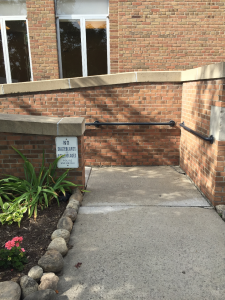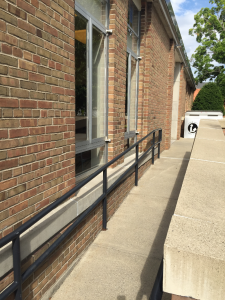Everyone is entitled to have access to a public building.
The Americans with Disabilities Act (ADA) was signed into law on July 26, 1990, by President George H.W. Bush. The ADA is one of America’s  most comprehensive pieces of civil rights legislation that prohibits discrimination and guarantees that people with disabilities have the same opportunities as everyone else to participate in the mainstream of American life “– to enjoy employment opportunities, to purchase goods and services, and to participate in State and local government programs and services”. The ADA was modeled after the Civil Rights Act of 1964, which prohibits discrimination on the basis of race, color, religion, sex, or national origin – and Section 504 of the Rehabilitation Act of 1973 — the ADA is an “equal opportunity” law for people with disabilities.
most comprehensive pieces of civil rights legislation that prohibits discrimination and guarantees that people with disabilities have the same opportunities as everyone else to participate in the mainstream of American life “– to enjoy employment opportunities, to purchase goods and services, and to participate in State and local government programs and services”. The ADA was modeled after the Civil Rights Act of 1964, which prohibits discrimination on the basis of race, color, religion, sex, or national origin – and Section 504 of the Rehabilitation Act of 1973 — the ADA is an “equal opportunity” law for people with disabilities.
To be protected by the ADA, one must have a disability, which is defined by the ADA as a physical or mental impairment that substantially limits one or more major life activities, a person who has a history or record of such an impairment, or a person who is perceived by others as having such an impairment. The ADA does not specifically name all of the impairments that are covered. To meet the needs of those with disabilities, public facilities must be designed and constructed in a manner that is readily accessible for individuals with disabilities.
These standards also apply to commercial facilities and state and local government facilities and are subject to the law. There are specific codes and standards that must be followed to ensure usability.
ADA Handicap Ramp Compliance Requirements: 
4.8.2 Slope and Rise
- Slope is the proportion of vertical rise to horizontal length.
- The maximum slope of a ramp in new construction is 1:12, meaning the height of a ramp should be no more than 1/12 of its length.
- The length of the run is restricted to 30 inches.
4.8.3 Clear Width
- The clear width, the space between the handrails, must be a minimum of 36 inches.
4.8.4 Landings
- Level landings areas are required at the top and bottom of each run.
- The landing needs to be at least as wide as the widest ramp running into it and a minimum of 60 inches in length.
- If the ramp changes direction at a landing, the minimum size for the landing must be 60 inches by 60 inches to accommodate for the turn radius of a wheelchair.
4.8.5 Handrails
- Handrails are required on both sides of a ramp, when the height of ramp is greater than 6 inches.
- If the handrails are not continuous, they must extend to at least 12 inches beyond the top and bottom of the ramp and must be parallel with the ground surface.
- Handrails must have a rounded edge to provide a safe gripping surface.
These ADA requirements were put in place to prevent discrimination based on disability. Everyone has the right to safely access a public facility. The ADA prohibits discrimination on the basis of disability in employment, State and local government, public accommodations, commercial facilities, transportation, and telecommunications. It also applies to the United States Congress.
The ADA Signing Ceremony documents the speech given by President George H. W. Bush when he signed the Americans with Disabilities Act (ADA) into law. In the video, President Bush speaks to an audience of activists, Congressional supporters, people with disabilities, and their families and friends gathered on the south lawn of the White House. The 22-minute film, provided to the Department by the George Bush Presidential Library, is being re-released on the Internet to increase awareness of the ADA and can be found HERE.








